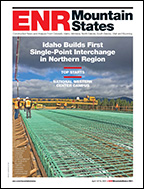Flipping Out
A 223-ft-long bridge is being constructed to carry Prince Road over I-10, and a third bridge will take the road over a Union Pacific Railroad track. The existing configuration crosses the railroad at grade, which has led to significant traffic snarls and accidents, Emery says. Forty to 60 trains use the line a day, but this could double due to a planned Union Pacific expansion.
Phoenix-based Pulice Construction is building cast-in-place concrete bridges, removing earth embankments currently elevating I-10 over Prince Road and constructing temporary detours to divert all traffic in phase one to one side of I-10, says Aaron Insco, Pulice project manager. To maintain three lanes of traffic in each direction at all times, all westbound traffic will be diverted to an existing two-lane frontage road that will be reconfigured into three lanes. Eastbound I-10 will detour onto the westbound I-10 lanes. After crews build half the bridges and reconstruct the freeway and eastbound frontage road, all traffic will shift to the east side as crews construct the other half of the project. Prince Road will be shut down for the duration of the project.
Most of the excavation from the I-10 embankments will be re-used to elevate the frontage roads that will tie into the top of Prince Road, but some 180,000 cu yd will be hauled away. Soft soil conditions have required nearly 400 drilled shafts as deep as 70 ft and 5 ft in diameter to support bridges and 30-ft-high retaining walls. Approximately 75,000 cu yd of concrete will be used on the project, excluding precast concrete being used for the bridge girders.
Past Presents
As crews slice away the embankments that used to elevate I-10, they will confront undisturbed earth that could contain archaeological artifacts—in fact, some artifacts already have been found during utility construction, Emery says. Construction activities will occur in two steps, pausing once crews reach virgin earth so that the archaeological team can survey and catalog the area. Meanwhile, Pulice will continue work in a pre-cleared area.
The project team also is looking out for the living. Because the area sees a lot of pedestrian activity that will be disrupted for the two-year-plus construction cycle, ADOT has set up a shuttle service to bring employees of nearby businesses to and from work on each side of the freeway. "This is the first time we've done that," Emery says. "There are a lot of firsts for us on this project."
Depending on how smoothly this project proceeds, ADOT is looking at performing a similar grade flip at the Ruthrauff Road interchange to the north. That project could go out to bid sometime after summer 2014. A year after that, Emery says they hope to reconfigure the Ina Road and I-10 interchange. “This is our test run,” he says. ”By the time we get to Ina, we should be really good at it.”





Post a comment to this article
Report Abusive Comment